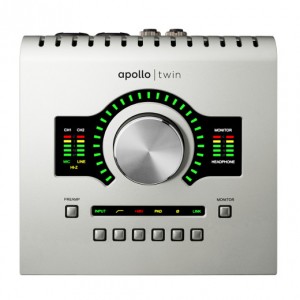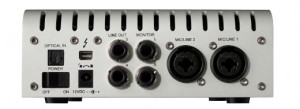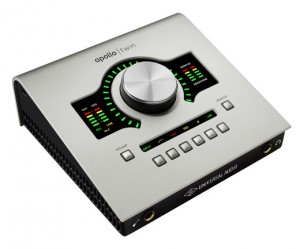Review: Universal Audio Apollo Twin DUO — by Rich Crescenti
Although the technology and methods used in our industry have changed and will continue to change, the overall goal of recording hasn’t evolved much at all: We still must start with a sound source, transducers to change the signals into other types of energy, and finally a storage medium for later playback.

The Apollo Twin DUO audio interface is reviewed here — packing double the processing power of the SOLO.
Consoles and tape have mostly been replaced by digital interfaces and software, but our desire to quickly and easily convert an abstract musical idea into a tangible and concrete production remains. The tools with which we work cannot make genius. However, when well executed they can inspire creativity and help us fully realize our goals.
Universal Audio has a long-standing history of creating high-quality audio gear that meets many needs of professionals. The Apollo 16 (reviewed 10-2013) is UA’s Flagship interface model, and, with the introduction of the Apollo Twin, UA is offering a product for bedroom recordists and pros on the go.
Modeling software and a reverence for the imperfections of yesteryear have created a strong a desire for a perfect blend of convenience and euphonic qualities in one small package. Can a small, portable interface be useful for professionals and hobbyists alike?
Connectivity
The Apollo Twin is available in two versions, the DUO, which has two SHARC DSP processing chips, and the SOLO, which has only one. The hardware IO and functionality of both units is identical. The Apollo Twin reviewed here is the DUO. Effectively, the DUO offers twice as much plugin processing power as the SOLO.
The Twin offers two XLR-Combo jack inputs at the rear of the device which can accept mic or line level signals, as well as a Hi-Z DI input at the front (which overrides the channel 1 input at the rear).
Users with existing converters can get eight additional inputs using the ADAT format (or fewer with S/MUX), or two additional inputs via S/PDIF using the TOSLINK input.
Outputs include stereo monitor outs, Line 3-4 outputs that can be used to carry cue mixes, and a headphone output as well. Computer connectivity is Thunderbolt only.
Unboxing
Taking a page from the Mac playbook, opening up the box to the Apollo Twin is an event: Superfluous materials are excised and the unit itself sits atop the opened box as if on a sales display.
Included in the box is the Apollo Twin itself, a power cable with international adaptors and cardboard card with a link and download instructions. No actual manual is included in the box and while I prefer an actual paper manual, this practice is now the norm.
Not included in the box is the Thunderbolt cable required for operation. It’s not a deal breaker. Thunderbolt cables are expensive and still too new a technology to be found laying around (as a USB or Firewire cable may be) and the cost must be factored into your purchasing decision.
Another Apple-esque move is the swift and automatic registration of the hardware to existing UA accounts. In the middle of another project when the unit arrived, I asked my assistant to take it for a test drive. Unfortunately for us, he already had a UA account and the unit was immediately and automatically registered under his name with no prompts or other options offered. It took three days to transfer the unit back over to my account. While this may not prove to be problematic for most users, it did raise an issue and it should be kept in mind if you plan to sell or share the unit.
Apart from my initial account issues, setting up the unit is a snap. The downloaded instructions can be watched on video or read via PDF and are clear and concise. The Apollo unit itself feels strong, durable and well-constructed. It feels as if this hardware was made to last, which is of paramount importance. Some portable interfaces can feel plastic-y or toy-like and that is not the case here.
The included power supply is unique and flexible. A blank power supply is provided that includes adaptors for all of your international power needs. This a great idea and the thoughtfulness is appreciated, but the execution is lacking: The power supply is fiddly, feels substandard for an interface of this quality, and too short in my opinion. However the cable does lock into the Apollo which prevents accidental disconnection: a thoughtful touch that more manufacturers should include.
Features and Usability
After setting the unit up, we brought in the very talented singer-songwriter Kristen Persinos to record a demo of one her songs.
Throughout the day we recorded vocals, electric guitar, bass, and percussion. We tested both the mic and DI inputs. On a separate session I recorded electric piano for Mitchell Leonard via the line inputs on the back.
Navigating the Apollo is effortless and intuitive. One large control knob can manage the gain of both mic/line inputs as well as the monitor/headphone volume. Clearly labeled function buttons offer a pad, polarity, low-cut, phantom power and even stereo-linking. In no time at all, I was using the Apollo as though raised on it.
The mic pre’s are very usable for most situations, and are fairly clean and neutral. They don’t add really any character or vibe when used as a stand-alone pre — I’m sure this is by design as real-time mic pre-modeling technology is where this unit really starts to shine.
The Console application is more or less UA’s software version of the input path with additional routing options. One of my favorite features of working on an analog console is the ability to control, alter, or process audio on the way to the multitrack. Console not only allows for this, but also offers the ability to control separate artist cue mixes and even offers aux sends for time-based effects as well. One can easily switch back and forth between mono and stereo monitoring. Also, one-touch functionality allows for recording with effects in place, or simply monitoring those effects.
Console is easy to set up and adjust, and those familiar with analog consoles will have no trouble adapting to it. Instantiating plugins is easy but dragging and dropping them into different orders is not offered. I love the ability to do this to test tonal variations, and I’d like to see UA incorporate this into future updates.
Unison is UA’s emulation of classic mic preamps. It works hand-in-hand with their Console application to offer the ability to track with mic preamp, equalizer, compressor and other plugin processing in place while still offering incredibly low latency for monitor mixes.
Although we had some initial trouble with double monitoring and latency, a quick friendly chat with the UA support team cleared the problem right up (make sure to select Low-Latency Monitoring, kids…). Upon further review this information is presented in the manual and I had just missed it in the initial read.
Low Latency monitoring can be set in many DAWs, (allowing musicians to hear themselves without an annoying delay) without the need for the Console application. However, this often requires setting the hardware buffer to very low levels. The downside of this is that many systems will become unstable at such settings, causing glitches and even potentially crashing the system. The ability to track and listen with processing at such low latencies using Console is a blessing, but it does involve an extra layer of software to navigate that some users may find bothersome.
An added bonus is that the Console application has a recall feature which can save many different configurations based upon user needs. Console also offers additional monitoring controls (mono, multiple sources) that can be difficult to achieve in some DAWs.
Included with the Apollo is a small but useful package of plugins to get you started. UA was gracious enough to also include all of their plugins for review, all of which are available for demo and purchase right from the application itself. Warning: this is dangerous to your bank account.
All of the plugins I tested (and I’m still working through them) sound, in a word, stunning. Mitchell and I routed his keys through the UA 610 emulation and the Ocean Way Room emulation. From the first chord struck, we were both impressed with the full and luxurious tones.
These plugins are some of the very best I have heard. Unfortunately, top-notch processing isn’t cheap, and it isn’t easy on your processor. Some of the more DSP-intensive plugins are only able to load a few instances before running out of juice. For me, this isn’t an issue. I’m a huge proponent of tracking with a clear end goal and using the plugs to commit to a specific sound. Users who like to backload all of their mixing decisions for the last minute may have a tough time with this.
Those users may consider supplementing the Twin with one of UA’s external PCIE or Firewire DSP Accelerator units. And while not currently offered, UA has assured me that later this year the Twin will be capable of linking together and working with the other Apollo units to make for a portable unit that can also easily expand and assist a designated-desktop setup.
A quick note for those looking to expand their current setup: The Apollo Twin doesn’t always offer full simultaneous connectivity with other interfaces. For example, I was unable to aggregate the IO of both the Apollo Twin and an Mbox Pro to combine the total number of inputs and outputs. However, I could use the MBox Pro as my main interface and still use the DSP offered by the Apollo Twin for plugin processing. This is no more caused by UA than AVID, but it’s still an issue.
Personally, I am always wary of tying together my hardware and software due to upgrading and format obsolescence concerns. The UAD Plugins only run off UA hardware and cannot run Native, so they are effectively tied to your interface.
Face the Interface
At the end of the day a piece of hardware must be evaluated for its target audience. And while this device is missing some key features I require in an interface (dim, monitor switching), the Apollo Twin remains a solid, well-designed piece of gear.
Retailing for $899 (the SOLO is $699), the Apollo Twin Duo is one of the few portable Thunderbolt interfaces . Compared to its competition, the Apollo is not cheap. Ultimately though, if you demand top-notch plugins, small footprint, and a superb build quality, the Apollo Twin Duo is well worth the asking price. Those in the market for a portable, great-sounding interface would do well to check it out.
Rich Crescenti is a freelance engineer, producer, teacher, and drummer who works out of several studios in NYC, helping bands make unique recordings. Rich also hits things with sticks for the Brooklyn-based rock band Bugs in the Dark.
Please note: When you buy products through links on this page, we may earn an affiliate commission.









Shane McGill
July 15, 2014 at 11:23 am (11 years ago)Great review, thanks!